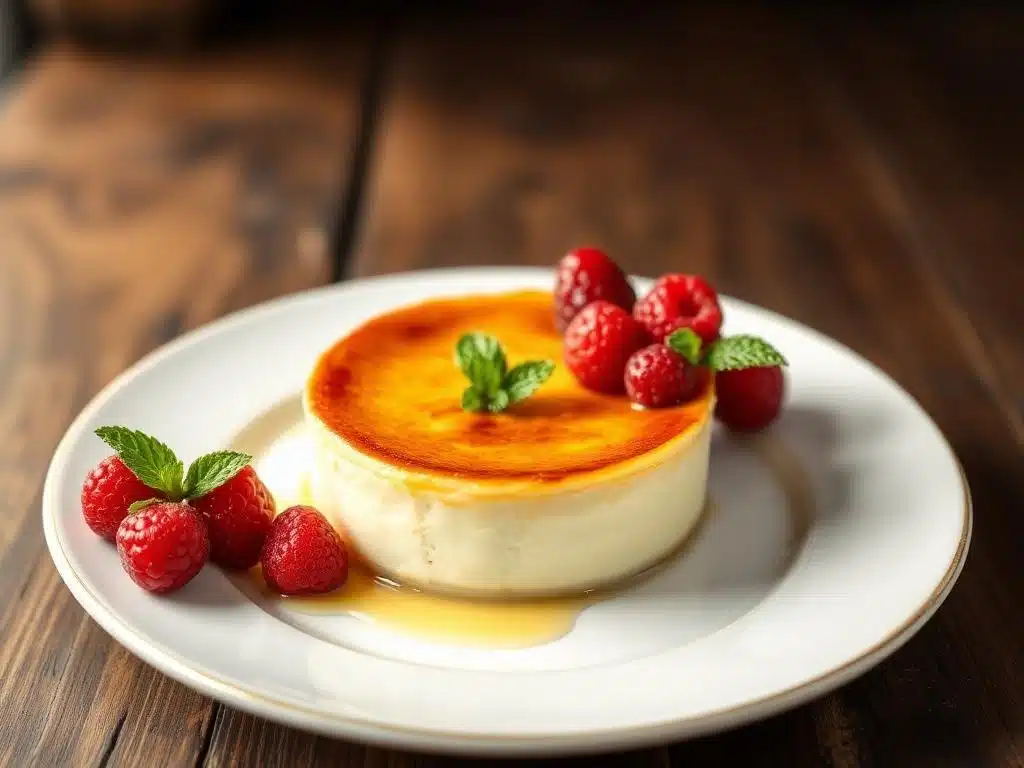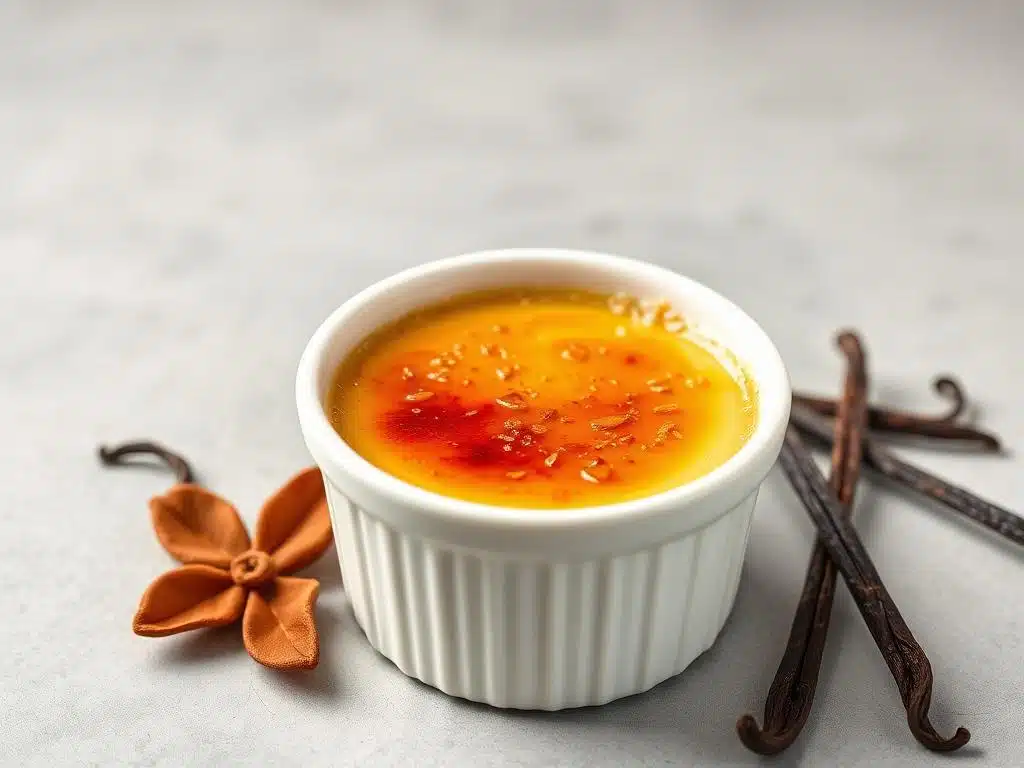Crème brûlée is a classic French dessert that has captured the hearts and taste buds of many around the world. With its rich, creamy custard base and a perfectly caramelized sugar topping, it’s no wonder this sweet treat is a favorite in restaurants and homes alike. But have you ever wondered what makes up this delightful dessert? In this article, we’ll dive deep into the ingredients that create the magic of crème brûlée, explore its variations, and even touch on the science behind its unique texture and flavor. So, let’s get started!
Introduction
What is Crème Brûlée?
Crème brûlée, which translates to “burnt cream” in French, is a luscious dessert that features a smooth custard base topped with a layer of hard caramel. Traditionally served in small ramekins, this dessert is often enjoyed for its delightful contrast between the creamy custard and the crunchy sugar topping. The beauty of crème brûlée lies not only in its taste but also in its simplicity, as it primarily consists of just a few key ingredients.
Importance of Understanding Ingredients
Knowing what goes into your food can enhance your appreciation for it. When it comes to crème brûlée, understanding its ingredients can help you make informed choices, whether you’re whipping it up at home or ordering it at a restaurant. Each component plays a crucial role in achieving that perfect balance of flavors and textures.
Overview of the Article
In this article, we’ll break down the essential ingredients of crème brûlée, explore the various flavoring agents that can elevate this dessert, and delve into the science behind its creation. We’ll also discuss popular variations and answer some frequently asked questions about this beloved treat. By the end, you’ll have a comprehensive understanding of what crème brûlée is mostly made of and how to make it yourself!
The Basic Ingredients
When it comes to creating the perfect crème brûlée, the magic truly lies in its basic ingredients. Each component contributes to the overall flavor, texture, and experience of this delightful dessert. Let’s take a closer look at the three primary ingredients that make up crème brûlée: egg yolks, heavy cream, and sugar.
Egg Yolks
Egg yolks are the backbone of any good custard, and crème brûlée is no exception. They provide richness and creaminess, giving the dessert its signature smooth texture.
- Role of Egg Yolks in Custard
The yolks act as a thickening agent when heated, allowing the custard to set properly. This is crucial for achieving that velvety consistency that melts in your mouth. - Importance of Using Fresh Eggs
Fresh eggs not only enhance the flavor but also ensure the best texture. When you crack open a fresh egg, the yolk should be bright and firm, indicating high quality. - Nutritional Value of Egg Yolks
Beyond their culinary role, egg yolks are packed with nutrients. They contain vitamins A, D, E, and K, along with essential fatty acids. So, while you indulge in this sweet treat, you’re also getting a bit of nutrition!
Heavy Cream
Next up is heavy cream, which is essential for creating that rich, luxurious mouthfeel that crème brûlée is known for.
- Why Heavy Cream is Preferred
Heavy cream has a high fat content, typically around 36% or more. This fat is what gives the custard its creamy texture and helps it set beautifully. Using lighter creams can result in a less satisfying dessert, so stick with heavy cream for the best results. - Differences Between Heavy Cream and Other Creams
While there are various types of cream available, such as light cream or half-and-half, they simply don’t cut it when it comes to crème brûlée. The richness of heavy cream is irreplaceable, making it a non-negotiable ingredient. - Impact of Cream Quality on Flavor
The quality of the cream you choose can significantly affect the flavor of your dessert. Opt for organic or high-quality cream whenever possible, as it will enhance the overall taste of your crème brûlée.
Sugar
Last but certainly not least, we have sugar, which plays a vital role in both the custard and the caramelized topping.
- Types of Sugar Used
Granulated sugar is the most common choice for crème brûlée. However, some recipes may call for brown sugar or even flavored sugars to add a unique twist. Each type of sugar brings its own flavor profile, so feel free to experiment! - Role of Sugar in Sweetness and Texture
Sugar not only sweetens the custard but also contributes to its texture. When combined with the egg yolks and cream, it helps create that silky smooth consistency that we all love. - Caramelization Process for the Topping
The magic happens when you torch or broil the sugar on top of the custard. This process caramelizes the sugar, creating a hard, glass-like crust that contrasts beautifully with the creamy custard beneath. It’s this delightful crunch that makes crème brûlée so irresistible!
Flavoring Agents in Crème Brûlée
While the basic ingredients of crème brûlée provide the foundation for this delightful dessert, it’s the flavoring agents that truly elevate it to a whole new level. From the classic vanilla to exciting alternatives, these additions can transform your crème brûlée into a unique culinary experience.
Vanilla
Vanilla is the quintessential flavoring for crème brûlée, and for good reason. It adds a warm, aromatic essence that perfectly complements the rich custard.
- Types of Vanilla
There are several forms of vanilla you can use, including vanilla extract, vanilla beans, and vanilla paste. Each has its own strengths:- Vanilla Extract: This is the most common choice and is convenient for home cooks. Look for pure vanilla extract for the best flavor.
- Vanilla Beans: Using whole vanilla beans can take your crème brûlée to the next level. The tiny black seeds add visual appeal and an intense vanilla flavor.
- Vanilla Paste: This is a blend of vanilla extract and ground vanilla beans, offering the best of both worlds.
- How Vanilla Enhances Flavor
The natural sweetness and floral notes of vanilla enhance the overall flavor profile of the custard. It balances the richness of the cream and the sweetness of the sugar, creating a harmonious dessert. - Alternatives to Vanilla
If you’re looking to switch things up, consider using other flavorings like almond extract or coconut extract. These can add a delightful twist to the traditional recipe, making it your own.
Other Flavorings
While vanilla is a classic choice, there are plenty of other flavoring agents that can add a unique touch to your crème brûlée.
- Citrus Zest
Adding a bit of lemon or orange zest can brighten up the flavor of your custard. The citrus notes provide a refreshing contrast to the richness of the cream, making for a delightful combination. - Liqueurs
While we’re avoiding alcoholic beverages in this article, you can still achieve similar flavors by using non-alcoholic extracts or syrups. For instance, a splash of orange syrup can mimic the flavor of Grand Marnier without the alcohol. - Spices
Spices like cinnamon or nutmeg can add warmth and depth to your crème brûlée. Just a pinch can transform the flavor profile, making it perfect for seasonal variations or special occasions.
Crème brûlée’s creamy base relies heavily on the perfect cream, so you might enjoy exploring what is considered sweet cream or discovering the unique characteristics of sweet cream butter. If you’re a dessert enthusiast, don’t miss our tips on how to firm up cream cheese filling or dive into the essentials of cream cheese filling.
The Science Behind Crème Brûlée

Understanding the science behind crème brûlée can help you master this classic dessert and appreciate the delicate balance of flavors and textures. From the custard formation to the caramelization process, let’s dive into the fascinating science that makes crème brûlée so special.
Custard Formation
At the heart of crème brûlée is its custard base, which is a delicate blend of egg yolks, heavy cream, and sugar. The way these ingredients interact is crucial for achieving that smooth, creamy texture.
- How the Ingredients Work Together
When you whisk the egg yolks and sugar together, you create a mixture that helps to aerate the yolks. This process not only adds a bit of volume but also helps to dissolve the sugar. When you gradually add the heavy cream, the mixture becomes rich and velvety. - Importance of Temperature Control
Temperature plays a vital role in custard formation. When cooking the custard, it’s essential to do so gently. If the mixture gets too hot, the proteins in the egg yolks can coagulate too quickly, leading to a grainy texture. To avoid this, use a double boiler or a water bath, which allows for even heat distribution. - The Perfect Cooking Time
The custard should be cooked until it’s just set but still slightly jiggly in the center. This ensures that it will firm up as it cools, resulting in that signature creamy texture.
Caramelization Process
The final touch that makes crème brûlée truly unforgettable is the caramelized sugar topping. This process not only adds a delightful crunch but also enhances the overall flavor.
- Explanation of the Maillard Reaction
When you apply heat to sugar, it undergoes a chemical reaction known as caramelization. This process transforms the sugar into a hard, glass-like crust. The Maillard reaction, which occurs when sugars and proteins react under heat, also contributes to the complex flavors of the caramelized topping. - Techniques for Achieving the Perfect Crust
There are a couple of methods to achieve that perfect caramelized top:- Using a Kitchen Torch: This is the most popular method. Simply sprinkle an even layer of sugar over the custard and use a kitchen torch to melt and caramelize the sugar until it forms a golden crust.
- Broiling: If you don’t have a torch, you can place the ramekins under a broiler. Keep a close eye on them, as the sugar can burn quickly.
- Cooling and Serving
After caramelizing the sugar, let the crème brûlée cool for a few minutes. This allows the sugar to harden, creating that satisfying crack when you tap it with a spoon.
Variations of Crème Brûlée
Crème brûlée is a versatile dessert that can be adapted in countless ways to suit different tastes and occasions. While the classic version is undeniably delicious, exploring variations can lead to exciting new flavor profiles and experiences. Let’s take a closer look at both classic and modern variations of crème brûlée, as well as some dietary alternatives.
Classic vs. Modern Variations
While the traditional vanilla crème brûlée is a timeless favorite, many chefs and home cooks have put their own spin on this classic dessert.
- Traditional Recipes
The classic crème brûlée recipe typically features a simple combination of egg yolks, heavy cream, sugar, and vanilla. This straightforward approach allows the rich flavors of the custard to shine through, making it a beloved choice for many. - Popular Variations
Here are some popular variations that you might want to try:- Chocolate Crème Brûlée: For chocolate lovers, adding melted chocolate to the custard base creates a rich and indulgent dessert. The chocolate adds depth and a luxurious texture that pairs beautifully with the caramelized sugar topping.
- Coffee Crème Brûlée: Infusing the cream with brewed coffee or espresso gives this variation a delightful caffeine kick. The coffee flavor complements the sweetness of the custard, making it a perfect after-dinner treat.
- Matcha Crème Brûlée: For a unique twist, consider incorporating matcha green tea powder into the custard. This variation not only adds a beautiful green hue but also introduces a subtle earthy flavor that contrasts nicely with the sweetness.
Dietary Alternatives
As dietary preferences and restrictions become more common, many people are looking for ways to enjoy crème brûlée without compromising their needs. Fortunately, there are several alternatives that can be just as delicious!
- Vegan Options
For those following a plant-based diet, you can create a vegan version of crème brûlée using coconut milk or almond milk in place of heavy cream. Silken tofu can be blended with these plant-based milks to mimic the creaminess of traditional custard. Sweeten with maple syrup or agave nectar, and you’ll have a delightful vegan treat! - Sugar-Free Alternatives
If you’re watching your sugar intake, consider using sugar substitutes like stevia or erythritol. These alternatives can provide sweetness without the calories, allowing you to enjoy crème brûlée without the guilt. Just be sure to check the conversion ratios, as some substitutes are sweeter than sugar. - Gluten-Free Options
The good news is that crème brûlée is naturally gluten-free! As long as you stick to the basic ingredients, you can enjoy this dessert without any modifications. Just be cautious with any flavorings or toppings you choose, as some may contain gluten.
Conclusion
Crème brûlée is more than just a dessert; it’s a delightful experience that combines rich flavors, creamy textures, and a satisfying crunch. By understanding what crème brûlée is mostly made of–egg yolks, heavy cream, and sugar–you can appreciate the artistry behind this classic dish.
Whether you stick to the traditional vanilla version or venture into exciting variations, the possibilities are endless. So, don’t hesitate to experiment with flavors and techniques to make this dessert your own.
Now that you’re armed with all this knowledge, why not try making your own crème brûlée? It’s a rewarding endeavor that’s sure to impress your family and friends. Happy cooking!
FAQs about Crème Brûlée
Crème brûlée is a beloved dessert, and with its popularity comes a variety of questions. Whether you’re a seasoned chef or a curious home cook, you might have some burning questions about this delightful treat. Let’s tackle some of the most frequently asked questions about crème brûlée.
1.What is the origin of crème brûlée?
Crème brûlée has a rich history that dates back to the 17th century. While its exact origins are debated, it is widely believed to have originated in France. Some sources even trace its roots to Spain, where a similar dessert called “crema catalana” is made. Regardless of its origins, crème brûlée has become a staple in French cuisine and is celebrated worldwide for its creamy texture and delightful caramelized topping.
2.Can crème brûlée be made in advance?
Absolutely! One of the great things about crème brûlée is that it can be prepared ahead of time. You can make the custard and refrigerate it for up to two days before serving. Just remember to caramelize the sugar topping right before you’re ready to serve. This ensures that the sugar remains crisp and crunchy, providing that satisfying contrast to the creamy custard.
3.What is the best way to store crème brûlée?
To store crème brûlée, cover the ramekins with plastic wrap or a lid to prevent any odors from the refrigerator from affecting the flavor. It’s best to store the custard without the caramelized sugar topping, as it can become soggy over time. If you’ve already caramelized the sugar, it’s best to consume it within a day for the best texture. If you need to store it longer, simply scrape off the topping and reapply fresh sugar before serving.
4.How do you achieve the perfect caramelized top?
Achieving the perfect caramelized top on your crème brûlée is all about technique. Here are some tips to help you get it just right:
- Use an Even Layer of Sugar: Sprinkle an even layer of granulated sugar over the cooled custard. Too much sugar can lead to a thick crust, while too little may not caramelize properly.
- Heat Source: If using a kitchen torch, keep the flame moving to avoid burning any one spot. If broiling, place the ramekins on a baking sheet and keep a close eye on them, as the sugar can burn quickly.
- Cooling Time: Allow the caramelized sugar to cool for a few minutes after torching or broiling. This will help it harden and create that satisfying crack when you tap it with a spoon.

